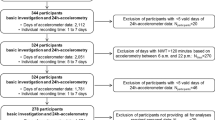Abstract
Objectives: Accelerometry was used to assess the relationship between the physical activity level (PAL) and time spent on activities of various intensities in children.
Design: A total of 20 children aged 8.6±3.3 y wore a triaxial accelerometer (Tracmor2) for 2 weeks. PAL was calculated with Tracmor2 output data. The fraction of time spent on activities with a given level of intensity (low, moderate, high) was calculated. The fractions of time spent on activities of different intensities were compared with previously obtained data for young adults and elderly persons.
Results: PAL showed an inverse relation with the percentage of time spent on low-intensity activities (r=−0.76; P<0.0001) and a positive relation with the percentage of time spent on high-intensity activities (r=0.93; P< 0.0001). The fraction of time spent on low-intensity activities was smaller in children than in young adults (P<0.05) and elderly persons (P<0.0001), while the fraction spent on high-intensity activities (P<0.0001) was larger.
Conclusions: The present data are important for a better understanding of physical activity in children, which is necessary for education and prevention about physical (in)activity in childhood. Our observations suggest that to obtain a higher PAL in children, they should be given the opportunities to perform high-intensity activities.
This is a preview of subscription content, access via your institution
Access options
Subscribe to this journal
Receive 12 print issues and online access
$259.00 per year
only $21.58 per issue
Buy this article
- Purchase on Springer Link
- Instant access to full article PDF
Prices may be subject to local taxes which are calculated during checkout


Similar content being viewed by others
References
Raad van de volksgezondheid en zorg (2002): Gezondheid en gedrag. Zoetermeer, the Netherlands, 1–152.
Bailey RC, Olson J, Pepper SL, Porszasz J, Barstow TJ & Cooper DM (1995): The level and tempo of children's physical activities: an observational study. Med. Sci. Sports Exerc. 27, 1033–1041.
Bouten CV, Verboeket-van de Venne WP, Westerterp KR, Verduin M & Janssen JD (1996): Daily physical activity assessment: comparison between movement registration and doubly labeled water. J. Appl. Physiol. 81, 1019–1026.
Council for physical education for children (1998): Physical Activity for Children: A Statement of Guidelines. Reston, VA: NASPE Publications.
Ekelund U, Sjostrom M, Yngve A, Poortvliet E, Nilsson A, Froberg K, Wedderkopp N & Westerterp K (2001): Physical activity assessed by activity monitor and doubly labeled water in children. Med. Sci. Sports Exerc. 33, 275–281.
Gerver WJM & de Bruin R (2001): Paediatric Morphometrics, A Reference Manual. Maastricht: Universitaire pers Maastricht.
Hoos MB, Gerver WJ, Kester AD & Westerterp KR (2003a): Physical activity levels in children and adolescents. Int. J. Obes. Relat. Metab. Disord. 27, 605–609.
Hoos MB, Plasqui G, Gerver WJ & Westerterp KR (2003b): Physical activity level measured by doubly labeled water and accelerometry in children. Eur. J. Appl. Physiol. 89, 624–626.
James PT, Leach R, Kalamara E & Shayeghi M (2001): The worldwide obesity epidemic. Obes. Res. 9 (Suppl 4), 228S–233S.
Meijer EP, Goris AHC, Wouters L & Westerterp KR (2001): Physical activity as a determinant of the physical activity level in the elderly. Int. j. Obes. Relat. Metab. Disord. 25, 935–939.
Molnar D & Livingstone B (2000): Physical activity in relation to overweight and obesity in children and adolescents. Eur. J. Pediatr. 159 (Suppl 1), S45–S55.
Rowland TW (1998): The biological basis of physical activity. Med. Sci. Sports Exerc. 30, 392–399.
Steinberger J, Moran A, Hong CP, Jacobs Jr DR & Sinaiko AR (2001): Adiposity in childhood predicts obesity and insulin resistance in young adulthood. J. Pediatr. 138, 469–473.
Westerterp K (2001): Pattern and intensity of physical activity. Nature 410, 539.
Westerterp KR (1999): Physical activity assessment with accelerometers. Int. J. Obes. Relat. Metab. Disord. 23 (Suppl 3), S45–S49.
Westerterp KR, Wouters L & Van Marken-Lichtenbelt W (1995): The Maastricht protocol for the measurement of body composition and energy expenditure with labeled water. Obes. Res. 3 (Suppl 1), 49–57.
Author information
Authors and Affiliations
Contributions
Guarantor: MB Hoos.
Contributors: MB Hoos collected data, carried out the statistical analysis, interpreted results and wrote the report. HK helped with the discussion of the results and contributed to writing of the report, W-JM Gerver had the original idea and helped to revise the report and KRW provided the know-how for the use of the Tracmor and helped to revise the report.
Corresponding author
Rights and permissions
About this article
Cite this article
Hoos, M., Kuipers, H., Gerver, WJ. et al. Physical activity pattern of children assessed by triaxial accelerometry. Eur J Clin Nutr 58, 1425–1428 (2004). https://doi.org/10.1038/sj.ejcn.1601991
Received:
Revised:
Accepted:
Published:
Issue Date:
DOI: https://doi.org/10.1038/sj.ejcn.1601991
Keywords
This article is cited by
-
Physical activity and energy balance
European Journal of Clinical Nutrition (2019)
-
Association between objectively evaluated physical activity and sedentary behavior and screen time in primary school children
BMC Research Notes (2017)
-
Effectiveness of enhanced cognitive behavioral therapy (CBT-E) in the treatment of anorexia nervosa: a prospective multidisciplinary study
BMC Psychiatry (2016)
-
Validation of the Actiheart activity monitor for measurement of activity energy expenditure in children and adolescents with chronic disease
European Journal of Clinical Nutrition (2010)
-
Movement analysis by accelerometry of newborns and infants for the early detection of movement disorders due to infantile cerebral palsy
Medical & Biological Engineering & Computing (2010)



